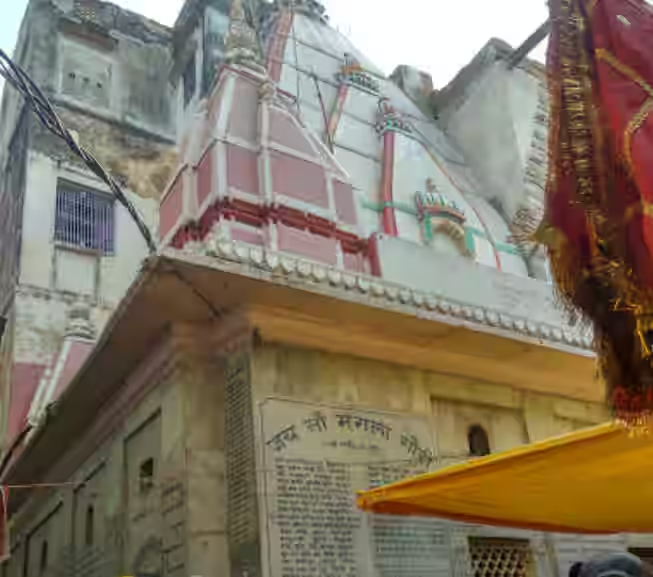Welcome to the Heart of Varanasi
This temple, Mangala Gauri, stands apart among other temples in India. Its blessings are very powerful, and it can grant great peace to anyone. People worship there for happiness, good health, and strong family ties.
Located in one of the oldest cities in the world, this temple speaks about hope and strength. Let us uncover this holy treasure.
Who Is Goddess Mangala Gauri?
She is revered as a form of Parvati, the consort of Lord Shiva. She is tender, affectionate, and dignified. It is widely believed that she grants peace, prosperity, and a good married life. Women worship her for the long life of their husbands and the welfare of their families.
Another of her attributes is motherhood and nurture. People seek her blessings for motherhood, joy, and protection.
The Story Behind the Temple
The temple has various origin stories. Sati was a goddess who fell in love with Shiva, according to Hindu mythology. After the untimely end of her life, it is said that their body parts fell into India and thus formed Shakti Peethas.
This temple is not one of the major Shakti Peethas, yet it does attract its power. Once inside, people feel a very strong divine presence in the temple. Over the ages, the temple has been visited and prayed to by many saints and devotees for meditation.
Design and Beauty of the Temple
The temple is not a big one, but it is beautiful. Its walls are made from old stone, and according to the Indian style, some carvings tell tales from Hindu scriptures. The walls are adorned with images of gods, goddesses, and sacred animals.
In the main part of the temple resides the statue of Goddess Mangala Gauri. Made from black stone, she has a very calm yet strong aura about her. The air is filled with divine sensations from lamps and flowers: incense also finds its way into the peace of the temple. Each small corner of the temple feels blessed and serene.
Special Days and Worship
Special days in the temple are Tuesdays. This is the day of Mangala Gauri Vrat, a fast undertaken by married women who come bearing sweets, flowers, and prayers, asking for love, harmony, and longevity for the well-being of their husbands.
The temple comes alive during Navratri and Sharad Purnima. People sing and dance, rejoicing, as they offer their prayers. Illuminations and festoons create a magnificent ambiance filled with chants. You can breathe in love and devotion.

How to Reach the Temple
You can find the Mangala Gauri Temple in the busy yet beautiful city of Varanasi. It’s close to many famous places like:
- Kashi Vishwanath Temple
- Dashashwamedh Ghat
- Manikarnika Ghat
If you’re traveling by train, the best station to get off at would be Varanasi Junction. However, flying into Lal Bahadur Shastri Airport is the other alternative. Taxis, autos, or rickshaws can be hired from the airport to get to the temple. Otherwise, the streets around it are very narrow, and walking might be a better idea for the last stretch.
You will be walking through colorful bazaars, street foods, and tiny shrines. Each step feels like stepping into the soul of India.
Temple Timings and Entry Rules
The temple is open daily with the following hours:
- Morning: 5:00 AM to 12:00 PM
- Evening: 4:00 PM to 9:00 PM
On certain festivals and special days, the temple remains open later than usual. Entry is free and open to everybody. However, modest dressing and decent behaviour are required from visitors.
Photography is generally not allowed in the sanctum. This is to maintain the peaceful spirit of the temple.
What Devotees Say
To sum it all up, many visitors have expressed their serene and hopeful feelings after visiting the temple. Some state that their prayers were answered almost immediately afterward. Others come every year to thank the goddess for her gifts to them.
Women who observe the Mangala Gauri fast claim that it brings in tremendous joy in their lives, while some share stories of how the goddess has helped them in their times of needs. Some were blessed with children, others with better relations.
Other Temples You Can Visit Nearby
Varanasi is full of divine places, and these are within a short walk or drive from Mangala Gauri Temple, including:
- The Kashi Vishwanath Temple – It is dedicated to Lord Shiva and is one of the twelve Jyotirlingas.
- Annapurna Temple – It is a shrine of the goddess who feeds the world.
- Durga Kund Temple – A temple dedicated to the fierce and protective Goddess Durga.
- Sankat Mochan Temple – Endearing Hanuman bhaktas.
- Tulsi Manas Mandir – A temple for the great epic Ramcharitmanas.
Best Time to Visit Mangala Gauri Temple
Opens every day of the year in the temple, which is most of the time the best month to visit, between October to February, when the weather is quite pleasing and cool. The early mornings are calm and the best time for prayer. The crowd becomes heavier during the festivals, but the energy becomes magical.
If it is to be a quiet visit, then it is better to avoid such days when there is a major festival in the temple. But if you want perky celebrations, visit during Navratri or Sharad Purnima.
Tips for First-Time Visitors
- Dress simply and soberly.
- Bring flowers or sweets to offer.
- Maintain silence while inside the temple.
- If you can visit during worship time, participate in the aarti.
- Hydrate yourself, especially during summer.
- Be kind and patient; the temple is for everyone.
Conclusion
More than a stone edifice, the Mangala Gauri Temple evokes faith, hope, and blessings in the heart of visitors. It soothes the mind, nourishes the heart, and uplifts the soul. People come to this temple to seek healing, pray, and rekindle hope in times of distress.
Whether you’ve just stepped into the temple as a novice or quite young, you would feel the special something around. Trust me; goddess mercy, the temple rituals, and the beauty of Varanasi shall dot your heart forever.
Come on, step in there and feel the warmth of the love that Goddess Mangala Gauri has for you. Be it an answer you seek, blessings, or mere peace, the temple welcomes all.
Also Read: Markandey Mahadev Varanasi Temple – Place of Faith and Legend


